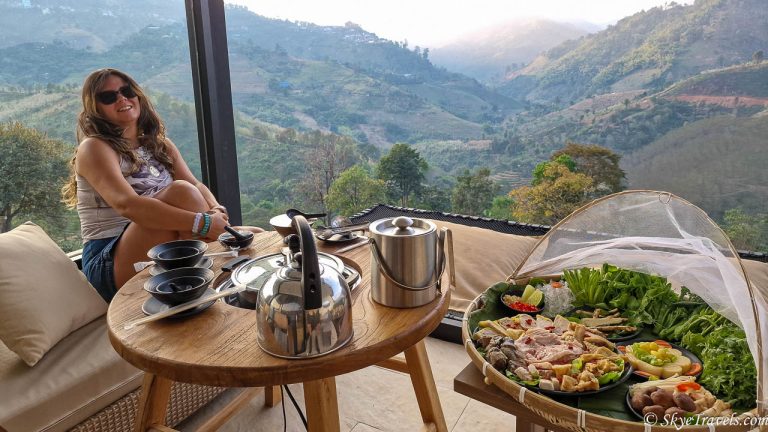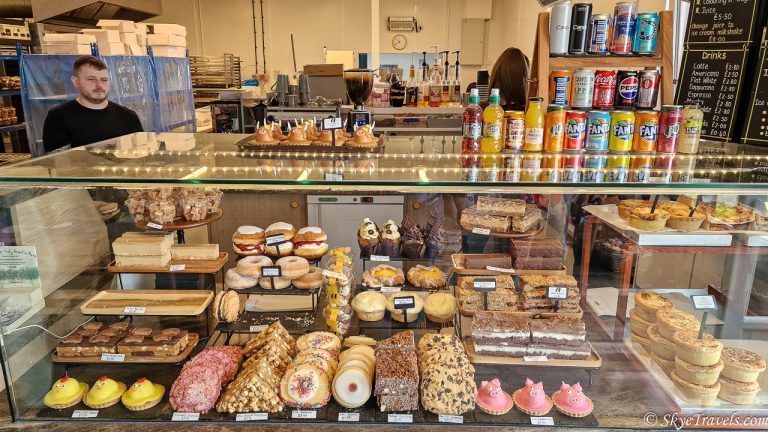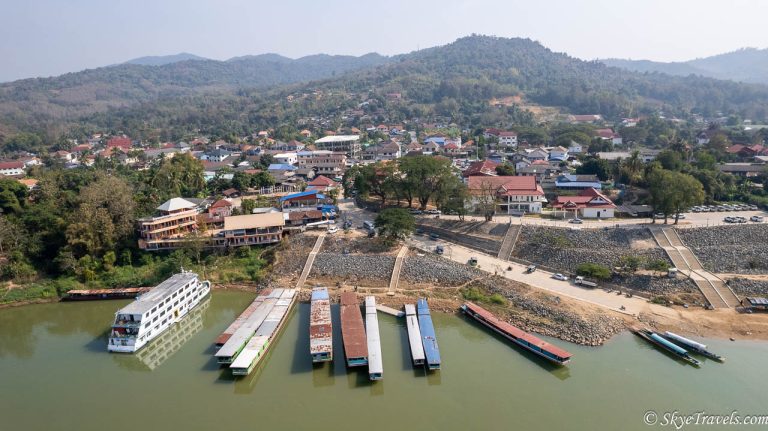On the second day of our week-long trip through central Portugal, we spend the day at the Convento de Cristo, aka Convent of Christ, a beautiful UNESCO World Heritage Site and one of the most important Templar cities on the Iberian peninsula.
Leaving the Aire and Candeeiros Mountains Natural Park
After leaving the Cooking and Nature Emotional Hotel where we had our Portuguese cooking class and spa treatment, it was time to make our way to Tomar, roughly 40 miles away. As we spent longer at the hotel enjoying the three pools, we were running late and didn’t have time to stop along the route.
Just a few miles northwest of the hotel is the town of Porto de Mos, and Batalha just beyond that. It was only after I left Portugal and started researching more about the trip that I realized we missed the Monastery of Bahalta, one of the 17 UNESCO World Heritage Sites of Portugal. The beautiful, Gothic architecture monastery dates back to the early 15th century.
As we continued to Tomar, we also passed by the village of Fatima where the Virgin Mary reportedly appeared in 1917 and gave three shepherd children prophecies about apocalyptic events coming in the following century, all of which have since come to pass. It was the last sighting of the Virgin Mary, and Fatima is now a pilgrimage destination for as many as 8 million travelers a year.
Convento de Cristo, a.k.a. Convent of Christ
The Convent of Christ was given UNESCO World Heritage Status in 1983, and for good reason. Originally built in the 12th century by the Knights Templar, the convent contained an entire town within the castle walls. Tomar was the last town built by the Templars, commissioned by the fourth Templar Grand Master Gualdim de Pais. After the Knights of Templar were disbanded in the early 14th century, the convent was taken over by the Knights of the Order of Christ, successors to the Templars, and further expanded over the centuries.
The original site covered 45 hectares (111 acres). The medieval town is no more, but the monastery is remarkably well preserved. The convent started off with the castle and a 16-sided church. A nave was added in the 1400s, and several cloisters were constructed over the two centuries after that. The details are amazing, both inside and out. We walked around for a good two hours, exploring all different parts of the convent.
Other than the central octagonal structure in the center of the church, I really loved the Window of the Chapterhouse, crafted by Diogo de Arruda in 1510. It’s a great example of the convent’s artwork, although it comes after the Templars.

Getting Footage with the Drone
Another great way to see the Convent of Christ is from above. I was very happy to learn I was allowed to fly my newly-acquired drone around Portugal’s ancient landmarks, and the Templar’s historic bastion was the perfect place to capture some footage from above.
From the drone, you can definitely appreciate just how big the Convent of Christ is. I mean, you get the sense of size walking around the hallways and courtyards, but it’s just not the same as flying above and taking it all in, as well as all the external decorations, buttresses, stained-glass windows, and other marvels of construction. The masons of the 1300s certainly knew what they were doing!
Visiting the Convent of Christ
The Convent of Christ is very easy to visit. There is a parking lot and a small cafe outside the castle walls. It’s paid parking but not expensive for a couple hours, which is plenty of time to visit the convent. The cafe serves good food at reasonable prices and also has bathrooms if you need them.
The convent is open year-round, except for New Year’s Day, Easter Sunday, May 1st, and Christmas Day. At the time of this writing, admission is €6 ($7), although you can get in free on Sundays and bank holidays before 2 p.m. Admission hours are 9 a.m. to 6 p.m. in the summer months, and until 5 p.m. the rest of the year.
Make sure to check the Convento de Cristo website for current hours and ticket prices.
An Evening at Sete Quintas
After Tomar, we had to get 44 miles due north to a “hotel” called Sete Quintas. Well, Google Maps calls it a hotel, but that’s a misnomer. I don’t even know what you would call our accommodations, other than wonderful. We made it just as the sun was setting, and had just a few minutes to take in how beautiful everything was.

It was only a few years ago when Carlos Pinto converted a small, derelict olive oil factory into a beautiful collection of cottages. Without photos on the walls, it would be hard to imagine the cluster of buildings were dilapidated, overgrown and missing roofs less than a decade ago.
The setting of Sete Quintas is quite idyllic. Located along a small stream, there’s a central house containing a kitchen, a dining room, a living room with a large fireplace for the winter, a few bedrooms, and a large room containing all the equipment of the original olive oil factory. Across from the main house are a couple cottages, and a swimming pool to use in the summer. There are also several friendly dogs and cats on the property to meet guests as they arrive.
A Local Dinner at Sete Quintas
As we arrived just as the sun was setting, it was also just in time for dinner. We dropped off our bags in the cottage and received a tour of the old olive oil manufacturing facilities from Carlos while his wife prepared a local dinner.
Our meal started with the staple Portuguese appetizer, but better – fresh-baked bread with olive oil manufactured in the local region, local cheeses, speck (cured ham slices), and melon. I personally wasn’t a fan of all the cheeses, but I could really appreciate how fresh and tasty they were. Vanesa loved them and the plate was quickly emptied.

The next course was migas and tibornada, a meal that would have been eaten by the olive oil factory workers, shepherds, and other workers in the region. Migas means “crumbs” and is made with breadcrumbs, salad greens, beans and pine nuts. Tibornada varies in its preparation, but it’s basically cod cooked with potatoes, olive oil and breadcrumbs, and sometimes served in a bread bowl.
Our dessert was a homemade tigelada, something similar to a creme-brulee made with eggs, milk, and sugar. I think ours was a regional variation, made with a sponge cake somewhat like a Scottish sticky toffee pudding (minus the dates). Altogether, the portions were quite large and we struggled to finish everything.

The meal might not have been as fancy as other places on our week-long tour through Portugal, but the dishes were delicious and it was clear how fresh all the ingredients were. Of course, we also had local wine with each course of our meal. I know I’ve said it before, but I rarely drink, except when I have to. When I’m in Portugal sampling all the local products, I have to drink the wine.
Sleeping in the Cottage
Our cottage was the “premium suite” with a living room complete with fireplace, a cozy bedroom, and a spacious bathroom. Unfortunately, with the fireplace in the living room, the bedroom was significantly colder, but that’s only a problem in the heart of winter (which is when we visited), and not when you have a partner that radiates heat all night long (that’s me).
Although not quite the same as the nearby Schist Villages, our cottage was built of stone and beautifully decorated. The bed was super comfortable, the comforter/duvet was very warm, and we had a great sleep there. As with each of our accommodations in Portugal, we only wish we could have stayed longer.
Breakfast in the morning was just as delicious as our dinner – fresh fruit, cheeses, sliced meats, fresh-baked bread, etc. Nothing particularly fancy, but all locally-sourced, fresh ingredients. I think we also had a delicious omelet, but if so, I devoured it before I remembered to take a photo.
With our bellies full, we said goodbye to Carlos, the cats, and beautiful Sete Quintas, and set off for our next adventure high in the nearby mountains. Check out my upcoming story about Portugal’s unique schist villages.

Further Reading
Here are some more articles about Portugal to plan your trip with.
- 9 Amazing Things to Do in Obidos for Your Itinerary
- Travel Advice: Finding the Best Accommodations in Santa Cruz, Portugal
- Follow in my Footsteps: Fish, Funiculars and 100-Foot Waves in Nazaré
- 24 Hours in Peniche – The Best European Surfing Town
- Follow in My Footsteps: The Santa Cruz that isn’t on Google Maps
Disclaimer: My endless thanks to Center of Portugal, and Sete Quintas for inviting me to these amazing locations. As always, my views and opinions are completely my own.
This post may contain affiliate links. These links help give me the wherewithal to continue traveling at no additional cost to you. For more information, click here.






























